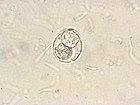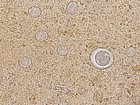Isospora spp.
Isospora suis
Scientific Classification
| Kingdom | Protista |
| Phylum | Apicomplexa |
| Class | Coccidiasina |
| Family | Eimeriidae |
| Genus | Isospora |
| Species | There are many e.g. Isospora suis. |
Life Cycle
There are essentially three stages in the Isospora life cycle. The first is called Sporogony and is the asexual stage of the parasite development. It occurs exogenously, and leads to the development of sporozoites in the oocysts. After this occurs, the oocysts are now deemed infective.
The host then ingests the infectious oocyst, and the digestive enzymes break down the oocyst wall, and release the infective sporozoites, which then go on to penetrate the intestinal villus epithelium, namely the jejunum and the ileum. Each sporulated oocyst contains 2 sporocysts each with 4 sporozoites. This stage will occur relatively quickly under optimal conditions of high humidity and temperatures between 20 and 40 degrees.
The next step is Schizogony. This is an asexual process which occurs endogenously. After the sporozoites invade the epithelia, they then form trophozoites. These trophozoites then form merozoites, which is known as merogony.
Gametogony then occurs, which is sexual division occurs endogenously, namely the intestinal cells.
- Many species occur
- All species are host specific
-
- Oocyst measures 20-50μm
- Usually direct life cycle
- Transmission via the oral-faecal route
- Some species use facultative intermediate hosts and form tissue cysts
- Transmission via faecal-oral route or by ingestion of the intermediate host

